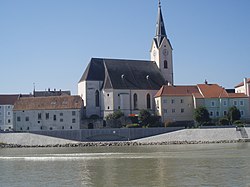Ybbs an der Donau
Ybbs an der Donau (German pronunciation: [ˈɪps]) (short: Ybbs) is a town in Austria. It was established in 1317. Throughout the town, from the intersection of the important trade routes and along the Danube the town has preserved a site that already had great economic importance during the Middle Ages. This is the reason for the very early award of incorporation as a town.
Ybbs an der Donau | |
|---|---|
 Church of Saint Lawrence | |
 Coat of arms | |
 Ybbs an der Donau Location within Austria | |
| Coordinates: 48°10′00″N 15°04′00″E | |
| Country | Austria |
| State | Lower Austria |
| District | Melk |
| Government | |
| • Mayor | Alois Schroll (SPÖ) |
| Area | |
| • Total | 23.82 km2 (9.20 sq mi) |
| Elevation | 224 m (735 ft) |
| Population (2018-01-01)[2] | |
| • Total | 5,653 |
| • Density | 240/km2 (610/sq mi) |
| Time zone | UTC+1 (CET) |
| • Summer (DST) | UTC+2 (CEST) |
| Postal code | 3370 |
| Area code | 07412 |
| Vehicle registration | ME |
| Website | www.ybbs.at |
Coat of arms
Description
On a silver shield lies a red city wall with battlements that an open gate and raised portcullis, which are dominated by two towers. Between the towers floats a green Linden bough, and the red-white-red Bindenschild.
Colors: Red-White-Red
Coat of Arms Bestowal: unknown; at least since the 14th century.
Toponymy
During the Roman Empire, a group of Egyptians lived here and built a temple dedicated to the goddess Isis. Isis lives on in the name Ybbs.[3]
Business and Infrastructure
- In northwestern Ybbs is the Ybbs-Persenbeug Power Station, the first river-water-run power plant on the Austrian Danube. WIlly Höhn, a Coburg native came from Stettin. In 1939, he insisted that one of his special constructions was implemented.[4]
- Between November 11, 1907, and September 22, 1953, Ybbs was on the Ybbser Highway, maybe the shortest tramway line in the world. It was 2.94 km long and connected the town with the Westbahn train station in Ybbs-Kemmelbach.
See also
Notes
- "Dauersiedlungsraum der Gemeinden Politischen Bezirke und Bundesländer - Gebietsstand 1.1.2018". Statistics Austria. Retrieved 10 March 2019.
- "Einwohnerzahl 1.1.2018 nach Gemeinden mit Status, Gebietsstand 1.1.2018". Statistics Austria. Retrieved 9 March 2019.
- Gombrich, E. H. A Little History of the World (2005) Yale University Press: New Haven. p.100
- Anna Rosmus Hitlers Nibelungen, Samples Grafenau 2015, pp. 208f
External links
- (in German) R.-k. The Parish of Ybbs an der Donau
- (in Italian) Bobbio, Italy
References
- The information in this article is based on and/or translated from its German equivalent.